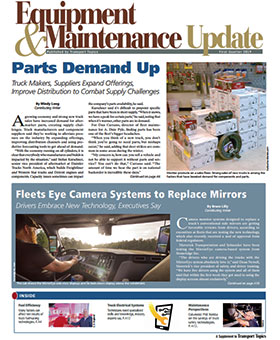Tackling Electrical Systems

Ignition failures, nonfunctioning lights and complete engine breakdowns all can signal problems with a truck’s electrical system.
But while most truck technicians know how to measure a truck’s voltage by using a multimeter, scores on a recent assessment of electrical knowledge by American Trucking Associations’ Technology & Maintenance Council suggest their knowledge of electrical troubleshooting often stops there.
“The average overall score on our 2018 online electrical knowledge assessment for medium- and heavy-duty truck technicians was 64%,” said Chris DiSantis, director of training and field technical support for Aim NationaLease.

“This tells us that when it comes to truck electrical systems, technicians are deficient in analytical skills, interpretation of multimeter readings and solving problems. That’s not what we expected,” said DiSantis, who chairs TMC’s Electrical Study Group.
The upshot is that fleets are wasting thousands of dollars because they don’t know enough about truck electrical systems or have the right tools to fix electrical problems, said Bruce Purkey, president of Purkeys Consulting.
“Fleets assume their technicians know how to do electrical repairs and have the right tools to do them, but that’s not always the case,” Purkey said. “Having the proper tools and training to detect problems and make correct repairs would go a long way toward saving fleets money.”
Years ago, truck electrical systems were limited to batteries, circuits and switches, circuit loads, wires and a ground. “Back then, you could use a regular pair of crimpers to make all your electrical repairs,” said Purkey.
Today, however, modern truck electrical systems include computers, electronics and multiple sizes of wiring. At the least, technicians now need specialized crimpers to gut splices and connect wires, Purkey said.
Tom Hendricks, director of learning and development at UPS Corporate Automotive, said poor wiring connections and breaks caused over time by a taxing duty cycle are the most common electrical problems found in UPS trucks.
To repair these issues, all UPS shops are equipped with a certain brand of specialized crimpers, laptop computers and diagnostic software, Hendricks said. UPS Inc. ranks No. 1 on the Transport Topics Top 100 list of for-hire carriers in North America.
“If you don’t have the right crimpers, you can violate the integrity of the connection you’re working on,” Purkey added. “When that happens, you expose wires and components to corrosion, and that’s a huge problem.”
Corrosion of wires and connectors caused by road salt is the largest electrical problem for trucks today, the industry experts said. Battery issues are next. “The harsh chemicals we put on roads attack truck electrical systems and have a severe corroding effect on electrical harnesses and connectors,” said DiSantis of Aim NationaLease.

Hogg
Homer Hogg, technical service director at TravelCenters of America, said that analyzing the quality and quantity of work at maintenance shops can tell maintenance managers how much their technicians know.
As one example, he noted that when chloride gets into a truck’s wires, resistance is created. Before electronics were introduced in trucks, “this might have meant that one of your lights was dim,” Hogg said. “But in today’s trucks, the light won’t work, and it’s possible none of them will, because the electronic signal being transmitted won’t make it to the intended location.”
Hogg said that overall, analysis of repair data can reveal repetitive repairs and costly part replacements that could have been avoided by doing proper repair the first time. Shops that don’t have systems that can look at repair data and trend it will fall behind, he said.
Meanwhile, UPS’ Hendricks said all test lights have been removed from their facilities. The diagnostic laptop has become the primary shop tool, and updated software is essential to proper diagnostics and resolution, he said. UPS’ procedure for troubleshooting truck electrical problems is to use a diagnostic computer for sensor or driveability concerns and a digital volt ohm meter to find the exact location of poor connections in the wiring, Hendricks said.
“Our policy is to repair as many vehicles as possible internally rather than send them to the dealership for repair,” he said.

Stuart
DWS Fleet Management Services CEO Darry Stuart said many fleets have problems with basic electrical techniques, such as wire clamping and routing. But he sees even more problems stemming from poor battery maintenance.
“If fleets would equip their trucks with the number of batteries recommended by the manufacturer and practice good maintenance by cleaning terminals and checking routing for corrosion, they’d eliminate the majority of perceived electrical problems,” he said.
Stuart thinks many technicians fear electricity and need training. First, training is needed on the use of multimeters and the care of batteries and then on truck electrical systems generally, he said.
“When technicians don’t understand a problem, many of them just throw parts at it,” Stuart said. “I’ve seen transmissions overhauled for $6,500 in trash trucks when the problem was corrosion and not enough electrical power to shift the transmission.”
But for small fleets in particular, training can be hard to get, Quality Transport Co. President Dave Dettman said.
“We have 25 trucks that we run to high mileage, and while both of our technicians are very good, the availability of training is a problem,” Dettman said. “We talk to our dealer all the time about expanding their training to allow fleets like ours to attend classes. But dealers have limited resources, too, so even if we paid to go, we wouldn’t be invited.”
To stay abreast of truck electrical and electronic technology, Dettman downloads the latest technical information from Freightliner and furnishes his technicians with laptops and the same diagnostic programs used by Freightliner dealers.
“We try to mirror what Freightliner technicians would do if the truck were in their shop,” he said. “But if we’re still unsure about something, we call our dealer and talk to them about it. Or we take the truck in for them to do the advanced electronics.”
Dettman thinks other small fleets should act similarly to solve their truck electrical problems.
“Try to hire the best technicians you can find, provide them with the best tools you can and be willing to give them the training they need, wherever you find it,” he said.

Legler
Meanwhile, Jack Legler, technical director of TMC, said the council offers more than 50 recommended practices covering various aspects of electrical maintenance and is working on more.
An RP on maintaining solar panels on trucks was recently released, and an RP for making ordinary wire and cable repairs is in progress. Also in the works is a revision to an RP, which will reflect the current state of truck electrical systems.
“As more devices, power systems and technologies are built into trucks, cutting-edge electrical knowledge and skills will be absolute necessities for technicians to keep fleet equipment operating at peak efficiency,” Legler said.
UPS is “constantly developing” advanced diagnostic safety and training courses to meet the needs of ever-changing vehicle components, Hendricks noted. “This is particularly true for our electric and hybrid electric vehicles.”
Legler also said technicians will need the expertise to work with multiple voltages. “Twenty-four and 48-volt systems will show up soon in electric heavy-duty trucks,” he said.
Martin Singh, vice president of maintenance and procurement at Trans-System Inc., said technicians at his shop needed training on battery care.
“Lack of battery maintenance was our fleet’s main electrical problem, so we hired a consultant to come out and train our technicians,” he said.
Before the training, Singh said if a driver complained that he needed a jump start or had no start at all, fleet technicians might replace the truck’s entire bank of batteries. “Or, if they couldn’t find the problem, they would just send the truck back out without cleaning the battery terminals or doing anything else, and the truck would break down again,” he said.
Since training was completed last June, Singh said battery replacement expenses have plunged nearly 50% and repair orders have fallen “from around 500 last year to 220 for the same period this year.”
Singh also said Trans-System invested in a specific type of battery tester and 100-amp battery chargers for every work bay. “Each time a truck comes in, we connect a battery charger to it to give the truck a full state of charge,” Singh said. “The charger also tells us if something is wrong with the truck’s battery bank and tells us to check that before charging.”
Trans-System now uses its most knowledgeable technicians to train others in electrical work. “Larger fleets can reach out to manufacturers or consultants for training, and smaller fleets need to align themselves with the dealer they buy their equipment from.”



